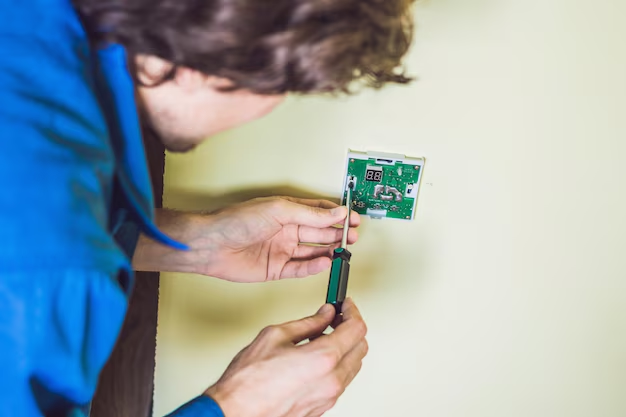Understanding Your Refrigerator Capacitor: How to Check and Troubleshoot 🧊
Has your refrigerator been acting up lately, perhaps not cooling as effectively as it used to? Or maybe it's not starting at all? A common yet often overlooked culprit in such scenarios is the refrigerator capacitor. Much like the heart in human anatomy, the capacitor ensures vital currents flow consistently, powering your refrigerator's compressor. Understanding how to check your refrigerator capacitor can save you time, money, and food wastage. This guide will explore everything you need to know about checking a refrigerator capacitor, offering you practical insights and reliable guidance.
What Is a Refrigerator Capacitor and Why Is It Important?
The Role of a Capacitor
A capacitor is a crucial electrical component found in many home appliances, including refrigerators. Its main job is to store electrical energy and release it during startup to boost the motor. This sudden release of energy helps the motor to kickstart effectively and keeps the refrigerator running smoothly.
Why Is It Crucial?
Without a functioning capacitor, your refrigerator's motor might struggle to start or not start at all, directly affecting the appliance’s ability to keep your food cool. This can result in spoiled groceries and higher electricity bills as the fridge works harder to compensate.
Common Signs of a Faulty Capacitor 🛠
Signs to Watch For
Here are a few symptoms indicating that your refrigerator’s capacitor might need a check:
- The refrigerator fails to start: If your fridge isn’t turning on, it could be because the capacitor isn’t providing the necessary kick to the motor.
- Humming sound without startup: A constant humming sound without the motor kicking in can signal a capacitor problem.
- Frequent cycling: The fridge starting and stopping often could indicate that the capacitor isn’t holding a charge properly.
- Poor cooling performance: If your food isn't as cold as it should be, it’s time to consider checking the capacitor.
How to Safely Check Your Refrigerator Capacitor
Preparing for the Task
Before you begin, ensure you have the following tools ready:
- Multimeter
- Screwdriver
- Insulated gloves
- Safety goggles
Always prioritize safety when dealing with electrical components by following these steps:
- Unplug the refrigerator: Make sure the power is completely disconnected to avoid any risk of electric shock.
- Wear safety gear: Put on insulated gloves and safety goggles to protect your hands and eyes.
Locating the Refrigerator Capacitor
Refrigerator capacitors are typically located near the compressor, usually near the back of the fridge. Here's how you can access it:
- Move the refrigerator: Slide it gently away from the wall to access the back panel.
- Remove the rear panel: Use a screwdriver to unscrew the back panel, exposing the compressor and the capacitor.
Testing the Capacitor with a Multimeter
Here’s a step-by-step guide to testing the capacitor with your multimeter:
- Discharge the capacitor: Before testing, safely discharge the capacitor by shorting its terminals using a screwdriver with an insulated handle to prevent shocks.
- Set the multimeter: Turn the multimeter to the capacitance setting, usually represented by a symbol resembling two parallel lines with a horizontal line between them.
- Take a reading: Place the multimeter leads on the capacitor terminals. The reading should match the capacitance value specified on the capacitor label. A significantly lower reading indicates a faulty capacitor.
What to Do If the Capacitor Is Faulty
Replacement Procedure
If the multimeter shows that the capacitor is faulty, replacing it is usually the best option. Here’s how you can do it:
- Purchase a compatible capacitor: Ensure the replacement matches the original in terms of voltage and capacitance.
- Remove the faulty capacitor: Gently detach the wires after noting their configuration.
- Install the new capacitor: Attach the new capacitor, ensuring the wires are correctly connected.
- Reassemble and test: Reattach the rear panel, plug the refrigerator back in, and check if it operates smoothly.
When to Seek Professional Help
While replacing a capacitor can be straightforward, if you’re unsure or uncomfortable handling electrical components, it’s always wise to call a professional appliance technician. This ensures your refrigerator is safely and properly fixed, preventing further issues.
Understanding Related Appliance Components 📚
Beyond capacitors, several other components play a critical role in your refrigerator’s operation:
The Compressor
The compressor circulates the refrigerant through the coils, enabling the cooling process. If the capacitor isn’t functioning, the compressor doesn’t receive the initial energy boost, often resulting in failure.
The Thermostat
A malfunctioning thermostat, while unrelated to capacitors, can also lead to cooling issues. It regulates temperature, so if it’s off, it may affect how cold the interior gets.
The Start Relay
This little device works with the capacitor to kickstart the compressor. A start relay failure often mimics capacitor failure, as both prevent the motor from starting.
Key Takeaways: Checking Your Refrigerator Capacitor Successfully 📝
Here’s a concise summary to help remember the key points covered:
- Identify symptoms: Poor cooling, a non-starting motor, and strange noises often indicate capacitor issues.
- Safety first: Always unplug and use proper safety gear when inspecting electrical components.
- Check and replace: Use a multimeter to test; replace faulty capacitors with compatible ones.
- Know when to call for help: Don’t hesitate to get professional assistance if unsure.
Keeping Your Refrigerator at Its Best
Proper maintenance can extend your refrigerator’s lifespan and enhance efficiency. Regularly clean the back area, ensuring the coils are dust-free. Inspect the gaskets for air leakages, which can strain the compressor needlessly.
By understanding how to check and manage your refrigerator capacitor, along with other key components, you can maintain a well-functioning kitchen hub where your food remains fresh and your energy consumption optimal. Stay savvy and your fridge will serve you loyally for years to come!
